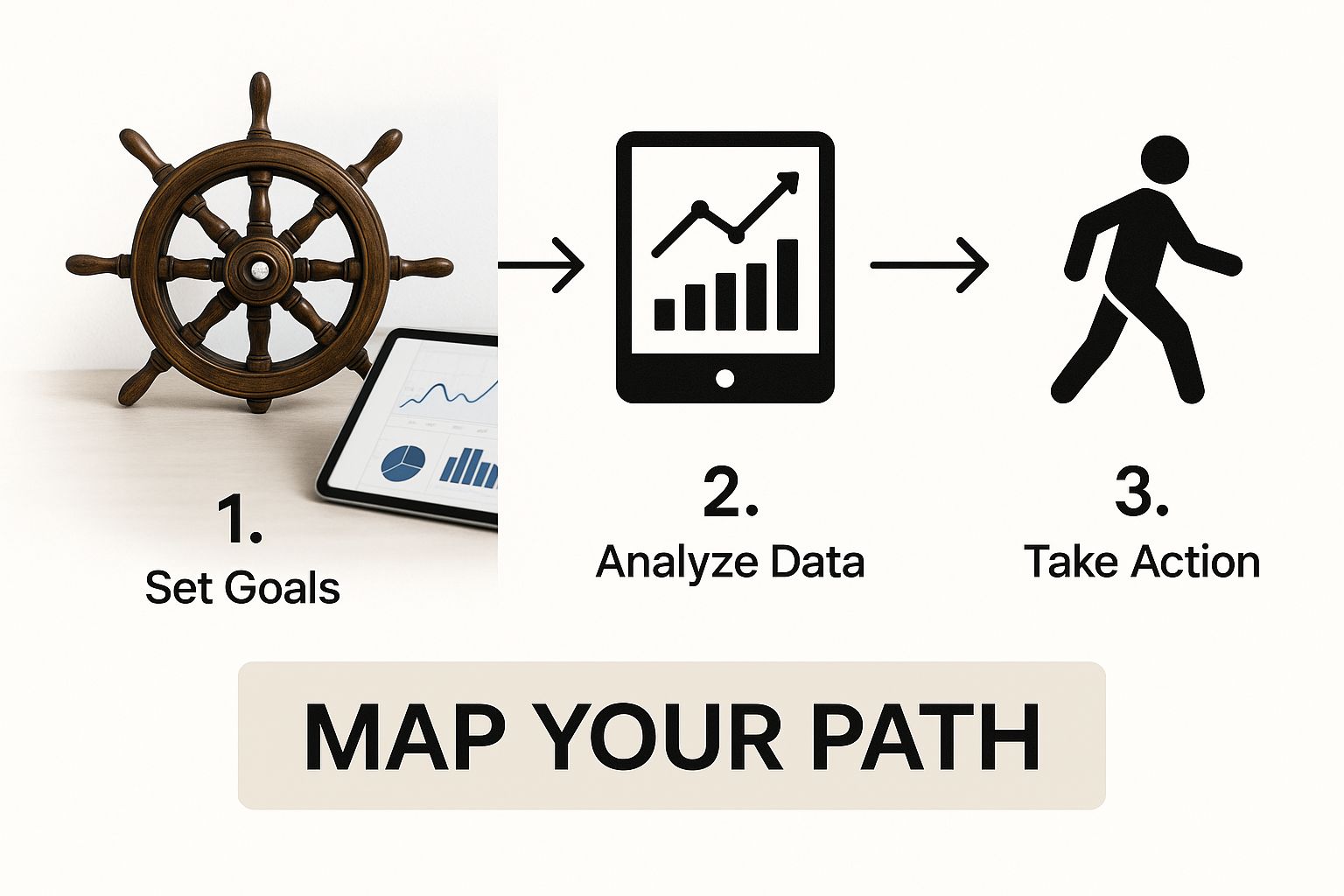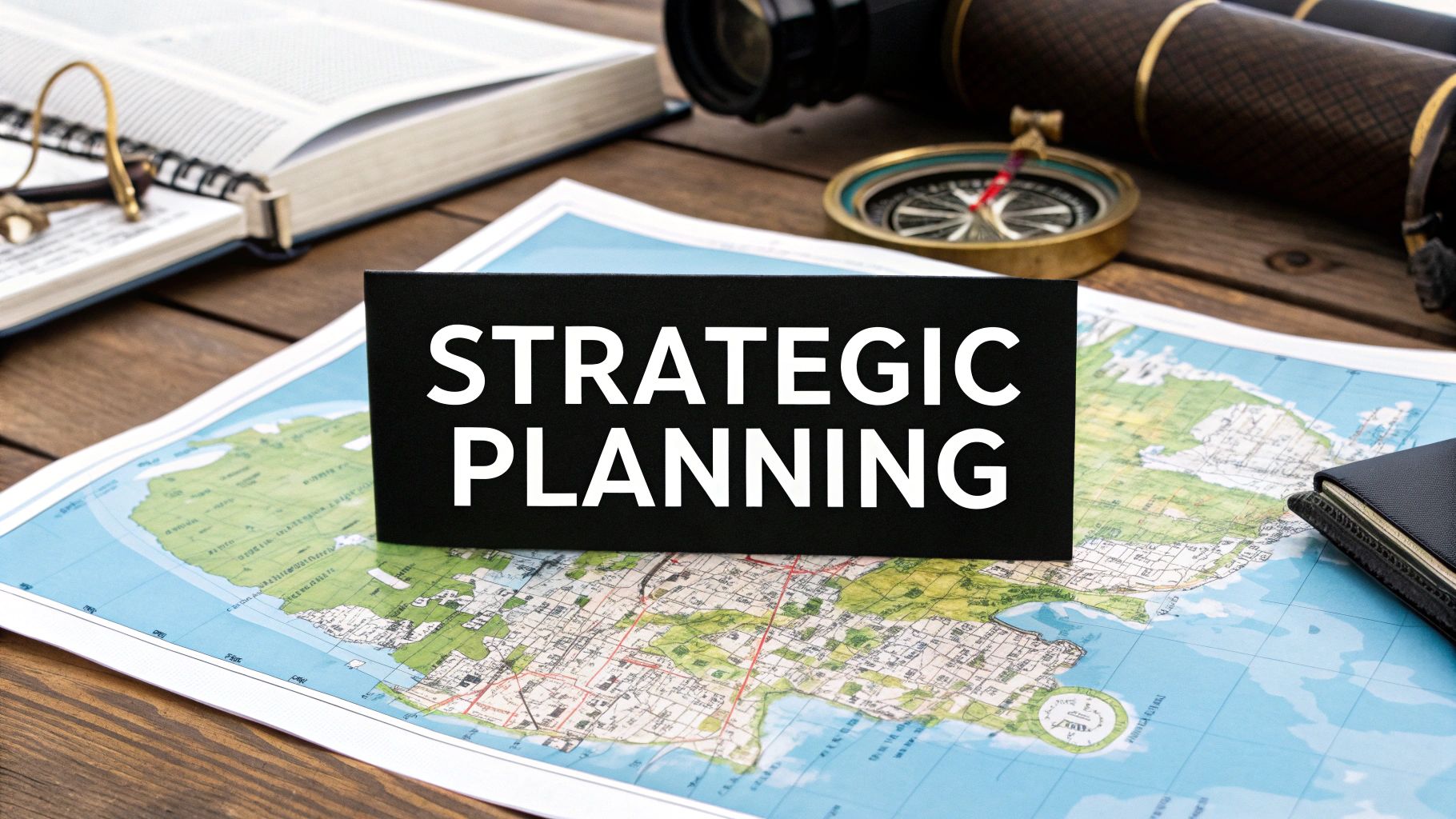What Is Strategic Planning Process? Key Steps Explained
The strategic planning process is how an organization methodically figures out where it's headed and dedicates the resources to get there. It’s a disciplined system for answering three fundamental questions: Where are we now? Where do we want to be? And how, exactly, will we make that happen?
What Is Strategic Planning Really About

Let's ditch the textbook definitions for a moment. Think of the strategic planning process as building a custom vehicle for a very specific journey. The plan itself isn't the end goal; the real work is in designing the company, fueling it with the right resources, and making the tough calls needed to arrive at your destination.
It’s best viewed as a continuous cycle, not a one-and-done event. You’re constantly assessing where your business stands today, visualizing where you want it to be in three to five years, and then meticulously planning how to bridge that gap. This creates a living system that keeps your organization aligned and agile in a market that's always in motion.
From Ancient Battlefields to Modern Boardrooms
The core ideas here are timeless. While modern business frameworks are a 20th-century invention, the principles of surveying your environment and positioning yourself for an advantage are ancient. The roots of strategic planning reach far beyond corporate offices, with some of the earliest concepts found in military strategy.
Even thousands of years ago, the best strategists knew you had to understand your own strengths and weaknesses just as well as the external threats and opportunities. They understood that adaptability was everything—a truth that remains at the heart of any successful business strategy today.
A Framework for Coordinated Action
At its core, the strategic planning process provides a framework that translates big, ambitious goals into coordinated, day-to-day actions. It's the critical mechanism that ensures everyone on your team—from the CEO down to the newest intern—is rowing in the same direction toward a shared vision.
Without it, you get chaos. Departments end up working against each other, precious resources are squandered on minor tasks, and the company drifts without a clear purpose. A solid strategic plan provides the clarity and focus required to achieve true organizational effectiveness.
A great strategy is a story well told. It provides a clear and compelling narrative about where the company is going and why it will succeed, making it easy for everyone to understand their role in the plot.
This process is what connects the high-level vision to on-the-ground execution, turning abstract ideas into tangible results. It’s all about making deliberate choices and ensuring every single action taken contributes to the same ultimate goal.
A well-defined strategic plan is built on several key pillars. Each component serves a distinct purpose, working together to create a cohesive and actionable roadmap for the entire organization.
Core Components of the Strategic Planning Process
| Component | Purpose | Key Question It Answers |
|---|---|---|
| Mission, Vision & Values | To define the organization's core purpose, long-term aspiration, and guiding principles. | Who are we, where are we going, and how will we behave? |
| SWOT/PESTLE Analysis | To assess the internal and external environment, identifying strengths, weaknesses, opportunities, and threats. | What is our current situation and what factors will impact our future? |
| Strategic Goals | To set high-level, long-term objectives that align with the mission and vision. | What do we want to achieve in the next 3-5 years? |
| Action Plan & Initiatives | To break down goals into specific, measurable, and time-bound projects or tasks. | What specific steps will we take to reach our goals? |
| Resource Allocation | To assign the necessary budget, personnel, and tools to execute the action plan. | What do we need to invest to make this happen? |
| Performance Metrics (KPIs) | To establish key performance indicators that will be used to track progress and measure success. | How will we know if we are on track? |
Understanding these components is the first step toward building a plan that does more than just sit on a shelf. It creates a dynamic guide that informs decisions at every level of the business.
How Strategy Evolved from Budgets to Battle Plans
To really get a handle on strategic planning today, you have to look at where it came from. It wasn't born overnight. It grew up out of necessity, transforming from a stuffy accounting task into the forward-looking discipline we know now.
Picture early sea captains. Their "planning" was a ship's ledger—a meticulous log of supplies and expenses. That's a pretty good parallel for business planning back in the 1960s. It was almost all about financial budgets and one-year forecasts. The whole point was to maintain control and keep things predictable in what was, frankly, a much simpler business world.
The Shift from Numbers to Foresight
This early version of planning, what you could call financial planning, basically assumed the future was just a slightly different version of the past. Companies would pull up last year’s financials, tack on a few percentage points for growth, and call it a budget. It was a completely internal focus, built on the dangerous assumption that the world outside the company walls wasn't going to change much.
Of course, it did. As markets got choppier and competition heated up, this rearview-mirror approach just didn’t cut it anymore. Business leaders realized they needed less ledger and more compass—something to help them navigate what was ahead. This gave rise to forecast-based planning, where companies started using trend analysis to project out a few years. It was a step in the right direction, but it still treated the future like a single, straight road.
This evolution didn't go unnoticed. Back in the 1970s, McKinsey & Company mapped it all out, identifying four clear stages: financial planning, forecast-based planning, externally oriented planning, and strategic management. Yet, even with this understanding, a later study revealed a huge disconnect: while 89% of companies had a formal planning process, only 36% felt it actually guided their most critical decisions. You can dig deeper into this history and its data by exploring the evolution of strategic planning on Wikipedia.
Embracing External Realities
The real game-changer was when companies finally started looking outside. This new phase, externally oriented planning, was a massive shift in thinking. Suddenly, strategy wasn't just about internal numbers; it was about understanding your place in the competitive arena.
Leaders began wrestling with the big questions:
- What are our competitors up to?
- Which way is the market tilting?
- What iceberg is lurking out there that could sink us?
The analogy shifts here, too. The ship's ledger gets replaced with radar and weather forecasts. Leaders were now actively scanning the horizon for storms and safe harbors, not just counting the barrels of rum. This mindset is what gave us powerful tools like SWOT analysis, which forces a company to square its internal strengths and weaknesses with the opportunities and threats of the outside world.
The essence of strategy is choosing what not to do. In an evolving market, focusing your resources becomes just as important as identifying new opportunities.
This outward-looking perspective forced businesses to become proactive. They stopped just reacting to market shifts after they happened and started trying to get ahead of them. The goal became building a business that was tough and flexible enough to handle whatever the future threw at it, not just the one future they were hoping for.
The Modern Era of Strategic Management
That brings us to today, to the era of strategic management. This is where everything comes together. It’s not a plan you create in a boardroom and then stick in a drawer. It’s a living, breathing system that weaves together your long-term vision with the nitty-gritty of daily operations.
Modern strategic planning is dynamic and deeply rooted in a company’s culture. It’s all about creating an agile organization that can pivot on a dime, learn from its environment, and constantly check that its actions are aligned with its North Star. This is why today's process is so obsessed with competitive intelligence, internal flexibility, and building a shared vision that empowers every single person to make smart, strategic choices on their own.
Navigating the Four Key Stages of Strategic Planning
Think of strategic planning less like a one-time project and more like a continuous journey. It’s not about creating a perfect document that sits on a shelf; it’s a disciplined, cyclical process that guides your company forward. We can break this journey down into four distinct but connected stages, each one critical for turning a big vision into tangible results.
This infographic lays out the path from initial analysis to ongoing adaptation.

As the image shows, a successful strategy is a mix of timeless navigation tools and modern data. It helps you plot a deliberate course while still being able to react to changing conditions.
Stage 1: Charting Your Position
Before you can plan a trip to a new destination, you have to know exactly where you are on the map. This first stage is all about a deep, honest look at your current standing—both internally at your company's capabilities and externally at the market around you.
The go-to tool for this is a SWOT analysis. It helps you catalog your:
- Strengths: What internal resources and attributes give you an edge?
- Weaknesses: Where are the internal disadvantages holding you back?
- Opportunities: What external factors could you turn to your advantage?
- Threats: What outside forces could potentially damage your business?
The biggest mistake here is rushing through it. A truly useful analysis requires digging into real data and getting honest feedback from people across the entire company, not just the leadership team.
Stage 2: Setting Your Destination
Once you know your starting point, it's time to decide where you're headed. This stage is where you craft the inspirational and directional pieces of your strategy—the compelling future that will get your whole team fired up and pulling in the same direction.
This is where you solidify your core identity and long-term ambitions.
Your vision statement is your North Star—a clear, vivid picture of the future you want to create. Your mission statement is your ship's purpose—it’s the why behind the journey itself.
With that foundation in place, you can define your high-level strategic objectives. These are the big, long-term goals you want to hit over the next three to five years. For a SaaS company, an objective might be something like, "Become the undisputed market leader for enterprise workflow automation."
Stage 3: Manning the Ship
Here’s where the rubber meets the road. A great plan is just a nice idea until you move it from the boardroom to the front lines. This implementation stage is often the hardest part because it's about turning those big-picture objectives into concrete, everyday actions.
Getting this right involves a few key activities:
- Break Down Objectives: Translate broad goals into specific, measurable, achievable, relevant, and time-bound (SMART) initiatives.
- Allocate Resources: Every initiative needs the right budget, people, and tools. A strategy without a budget is just a hallucination.
- Assign Ownership: Make sure every single task has a clear owner who is accountable for getting it done. Without accountability, things fall through the cracks.
This stage demands excellent communication and project management. Everyone needs to understand their role and see how their work connects to the bigger picture. In fact, 86 percent of leaders believe a strong, well-executed plan directly boosts revenue. To get a better sense of how theory turns into action, check out these Strategic Planning Process Steps.
Stage 4: Adjusting the Sails
No journey ever goes exactly according to plan. The final stage of strategic planning is a continuous loop of monitoring, evaluating, and adapting. Markets shift, competitors launch something new, and unexpected internal challenges pop up. A plan that can't adapt is a plan that's already failed.
This is where Key Performance Indicators (KPIs) are essential. These are the specific metrics you track to see if you're making progress toward your objectives. For that goal of market leadership, your KPIs might include market share percentage, customer acquisition cost (CAC), and the growth rate of new enterprise clients.
Reviewing these metrics regularly allows you to make smart adjustments. This is the heart of what it means to be a data-driven organization—making choices based on real performance data, not just gut feelings. To sharpen this skill, it helps to understand the core principles of data-driven decision-making.
By embracing this final stage, strategic planning becomes a dynamic management system, not a one-off event. By constantly checking your progress and adjusting the sails, you can keep your company on course, no matter which way the wind blows.
Choosing the Right Strategic Framework for Your Business

Once you’ve mapped out the stages of your strategic plan, you need to pick a framework to actually bring it to life. A strategic framework isn't a rigid rulebook; think of it more like a toolkit. It gives you the structure to organize your thinking, focus your actions, and see if you’re actually making progress.
It’s a bit like building a house. You wouldn't try to use a hammer for every single task—sometimes you need a saw, other times a level. The right framework for your company really depends on your size, your culture, and the specific problems you’re trying to solve. Choosing the right one is what turns a great idea on a whiteboard into a tangible business outcome.
The Balanced Scorecard: For Holistic Performance Management
The Balanced Scorecard (BSC) was created to break away from the old-school habit of only looking at financial numbers. Developed back in the 1990s, it gives leaders a much fuller, more "balanced" view of the company’s health by examining performance from four key angles. The whole point is to make sure that hitting this quarter's revenue target doesn't accidentally sabotage your long-term growth.
Those four perspectives are:
- Financial: How do we look to shareholders? This is where your classic metrics like revenue, profit, and ROI live.
- Customer: How do our customers see us? This digs into customer satisfaction, retention rates, and your slice of the market.
- Internal Business Processes: What do we absolutely have to nail? This pinpoints the critical operations you need to perfect to keep customers happy and hit financial goals.
- Learning and Growth: How do we keep getting better? This focuses on your company culture, technology, and employee skills—the engine for all future success.
The BSC works wonderfully for established organizations that need to get every department marching in the same direction. For a fast-moving startup, however, it can feel a bit cumbersome and slow to get off the ground.
OKRs: For Agile Goal Setting in Fast-Paced Teams
You’ve probably heard of Objectives and Key Results (OKRs). This is the framework that helped companies like Google and Intel scale at incredible speeds. It’s built for simplicity and alignment, which makes it a fantastic fit for agile B2B and SaaS companies that need to adapt quickly.
The structure couldn't be simpler.
An Objective is what you want to achieve, stated in a way that’s ambitious and easy to remember. A Key Result is how you’ll measure your progress toward that objective, using hard numbers. Typically, you’ll have 3-5 Key Results for every Objective.
For example, your Objective might be to "Become the Go-To Solution for Mid-Market B2B." Your Key Results could then be: "Increase qualified enterprise leads by 40%," "Achieve a Net Promoter Score (NPS) of 60 or higher," and "Reduce monthly customer churn to less than 2%."
OKRs are usually set quarterly, creating a natural rhythm of focused work followed by reflection and recalibration. The biggest pitfall is setting them poorly. If your Key Results aren't truly measurable or your Objectives aren't ambitious enough, you’ll just end up with a team that’s busy but not making real progress.
Hoshin Kanri: For Aligning the Entire Organization
Hailing from Japan, Hoshin Kanri (roughly "policy deployment") is a powerful method for ensuring that a company's high-level strategy actually drives action at every level of the business. Its entire purpose is to create a direct line of sight from the CEO's vision down to the daily tasks of an entry-level employee.
This framework is very systematic. It starts with leadership defining a few critical breakthrough objectives. These are then cascaded down, with each department and team creating their own goals that directly support the ones above them. This process involves a back-and-forth dialogue called "catchball" to make sure the goals are realistic and that everyone is on board.
Hoshin Kanri is a game-changer for large companies where strategy often gets lost in translation. For example, a top-level goal to improve profitability could lead a team to explore actionable strategies for cost optimization as their direct contribution. The main challenge? It demands incredible discipline and a culture of open communication to work.
Comparing Strategic Planning Frameworks
So, how do you decide which one is for you? This table breaks down the core differences to help you find the best fit for your company's goals and culture.
| Framework | Best For | Core Focus | Primary Benefit |
|---|---|---|---|
| Balanced Scorecard | Mature, stable organizations needing comprehensive performance measurement. | Balancing financial, customer, internal, and growth perspectives. | Provides a holistic, 360-degree view of business health. |
| OKRs | Agile, fast-growing companies (especially in tech/SaaS) that need to adapt quickly. | Setting ambitious, measurable goals on a short-term cycle (usually quarterly). | Creates intense focus, alignment, and transparency around key priorities. |
| Hoshin Kanri | Large, complex organizations where strategic alignment is a major challenge. | Cascading a few critical "breakthrough" objectives down through every level. | Ensures the entire company is pulling in the same direction on top priorities. |
Ultimately, the best framework is the one your team will actually use. Don't be afraid to test one out, see how it feels, and adapt it to fit the unique rhythm of your business. The goal is progress, not perfection.
Common Mistakes That Sink Strategic Plans
Even the most brilliant strategic plan can fail. It’s rarely the ideas that are the problem; it’s the process. A beautifully bound document is worthless if it just gathers dust on a shelf. The first step to building a strategy that actually works is understanding the traps that trip up so many companies.
Too many organizations pour a ton of time and energy into the planning phase, only to see all that momentum vanish when it's time to execute. They treat strategy like a one-off event—a frantic week of off-site meetings—instead of what it really is: an ongoing, living part of how you manage the business. What they end up with is a plan that’s completely out of touch with day-to-day reality.
Securing Buy-In Without True Involvement
One of the quickest ways to kill a strategic plan is to create it in an echo chamber. A few senior leaders lock themselves in a room, hammer out what they think is a genius plan, and then "unveil" it to the rest of the company, expecting everyone to just get on board. This top-down approach almost never works.
Why? Because employees who had zero input in the plan feel zero ownership of its success. It’s just another order from the top, disconnected from their actual work and the valuable insights they have.
True buy-in doesn't come from a fancy presentation; it comes from participation. When people feel heard and see their fingerprints on the final plan, they become its biggest advocates, not just employees following a checklist.
Instead of trying to sell your plan after the fact, build consensus from the very beginning. Pull in key people from every level of the company during the early analysis and brainstorming sessions.
Communicating the What but Not the Why
Another classic mistake is focusing only on the "what"—the new goals, the metrics, the initiatives—without ever explaining the "why." Leaders will roll out a new set of objectives without telling the story behind them, leaving everyone wondering why these changes are so critical for the company's future.
Without that context, employees are left feeling confused, unmotivated, and even cynical. It feels like just another "strategy of the month" when teams are constantly yanked in new directions without any real explanation.
To get this right, you need to frame your strategy as a compelling story:
- The Challenge: What’s happening in the market, or what weaknesses do we have that we must address?
- The Vision: What does winning look like for us? Paint a clear picture of that successful future.
- The Path: How, exactly, will these specific goals get us from where we are now to that winning future?
Creating a Plan Without a Budget
A strategy without resources is just a wish list. It's shocking how often companies finalize a strategic plan without ever connecting it to the annual budget. Teams get handed ambitious new goals but are given no extra funding, no new hires, and no better tools to make it happen.
This disconnect sets you up for failure before you even start. It also sends a clear message to the entire organization: this "strategy" isn't a real priority. For a plan to have any teeth, resource allocation has to be a central part of the process, not a late-stage consideration. Every single initiative in your plan needs a corresponding line item in the budget.
This also means tying your plan to real financial metrics. Learning how to measure business growth is about more than just top-line revenue; it's about understanding the ROI on your strategic bets. This keeps your plan grounded in reality and ensures it can actually be sustained over the long haul.
Got Questions About Strategic Planning? We've Got Answers.
Even when you have the frameworks and steps laid out, the real questions pop up when it's time to roll up your sleeves. Let’s tackle some of the most common on-the-ground concerns that managers and teams run into when moving from theory to practice.
These are the questions that come up after the PowerPoint is closed and the real work begins. Getting this part right is what keeps the momentum going and turns your planning efforts into actual results.
How Often Should We Create a Strategic Plan?
For most companies, a major strategic planning session happens every three to five years. Think of this as plotting a new, multi-year voyage. It’s a long enough timeline to chase after big, ambitious goals, but short enough that you don’t lose touch with a rapidly changing market.
But here’s the crucial part: it’s not a "set it and forget it" exercise. The plan needs to be a living, breathing document.
You should be conducting annual reviews to see how you’re tracking against those long-term goals and make any necessary course corrections. Many successful companies also get into a quarterly rhythm—like with OKRs—to review progress on the shorter-term initiatives that are actually pushing the big strategy forward.
Your strategic plan is a compass, not a GPS with turn-by-turn directions. Regular check-ins ensure you're still heading toward your North Star, even when you have to navigate around unexpected storms.
This mix of long-term vision and short-term agility is what separates a useful strategy from a document that just gathers dust. The goal is to stay laser-focused on the destination while being smart and flexible about the journey.
Who Should Be Involved in the Process?
The short answer? More people than you probably think.
While senior leadership is ultimately on the hook for the final direction, the most effective what is strategic planning process isn't a top-down mandate. It’s a group effort.
Bringing a wider group into the fold does two incredibly important things:
- You get better intel. Your frontline employees, department heads, and even key partners often have the clearest, most unfiltered view of your real-world strengths, weaknesses, and customer headaches.
- You get way more buy-in. When people feel like they had a voice in creating the plan, they develop a sense of ownership. They're not just executing someone else's vision; they're bringing their plan to life.
Of course, your core planning team will be the executive suite. But make sure you actively pull in feedback from middle managers, top-performing individual contributors, and even a few trusted customers during the initial assessment and brainstorming phases.
What Is the Difference Between Strategic and Operational Planning?
This is a big one, and it causes a lot of confusion. The simplest way to think about it is scope and timeframe. Strategic planning is about the big picture and the long haul. Operational planning is about the nitty-gritty details of right now.
Let's use an analogy.
Imagine your company is a fleet of ships setting out on an expedition.
- Strategic Planning is what the fleet's admiral does. They decide which ocean to sail (the market you’re targeting), which distant island to conquer (your major long-term goal), and the overall formation of the ships (your organizational structure). It answers the "what" and "why."
- Operational Planning is the work of each individual ship captain. They're plotting the daily course, managing the crew’s duties, and making sure the ship is stocked with enough supplies to complete its part of the mission. This answers the "how" and "who."
You can't succeed without both. A brilliant strategy is just a dream without solid operations to make it happen. And perfectly executed operations are a waste of energy if they’re moving the company in the completely wrong direction. A great strategic plan ensures that every team's operational plan is directly supporting the same overarching goals.
How Do We Keep Our Strategic Plan from Failing?
Business history is littered with beautifully crafted strategic plans that ended up as expensive paperweights. Research consistently shows that while most companies have a plan, a huge chunk of them struggle to see it actually influence their most important decisions. The secret is to bake execution into the process from day one.
Here are a few non-negotiable practices:
- Communicate Relentlessly: Don't just announce the plan in a single all-hands meeting and call it a day. Talk about it constantly—in team huddles, one-on-ones, and company updates. It needs to stay top of mind for everyone.
- Link It to Everything: The strategy has to be hardwired into your business. It should directly influence budgets, shape individual performance goals, and guide hiring priorities. If it isn't connected to these core functions, it isn't real.
- Establish a Review Cadence: Lock in quarterly meetings to review progress on your KPIs. Make these meetings sacred. This creates accountability and gives you a regular forum to adapt the plan as conditions change.
At the end of the day, a strategic plan isn't a project you complete. It's a management tool you use. Success comes when it becomes the central pillar around which all other business activities are organized.
Ready to stop wishing for growth and start building the systems that make it inevitable? At MakeAutomation, we specialize in creating the automated workflows and processes that turn your strategic goals into reality. Book a discovery call today and let's build your path to 7-figures.







